Si això fos un conte
Si això fos un conte
buscaria un lloc segur
per amagar el meu cor.
El posaria dins una maragda
amagada al niu d’una àguila
a la torre més alta d’un castell.
I el castell estaria en un país llunyà,
a moltes muntanyes, boscs i rius de distància.
Als camins hi hauria posat de guàrdia
llops i bruixes, gegants i dracs.
Sota cada pont hi viuria un troll,
amb un enigma per endevinar.
A cada bosc habitaria una fera,
intel·ligent com la fam.
Cada casa on passar la nit
seria un parany.
Cada tasca que acceptessis
una prova impossible.
Cada poma que et fos oferta
tendria un cuc a dins.
El castell fóra inexpugnable,
defensat per un exèrcit invicte.
I tot això seria inútil
perquè les princeses com tu
sempre se surten amb la seva.
Josep Lluis Aguiló
Gràcies Albert V., gràcies, gràcies.

Volverán las oscuras golondrinas
Volverán las oscuras golondrinas
en tu balcón los nidos a colgar,
y otra vez con el ala a sus cristales
jugando llamarán.
Pero aquellas que el vuelo refrenaban,
tu hermosura y mi dicha al contemplar;
aquellas que aprendieron nuestros nombres,
¡ésas no volverán!
Gustavo Adolfo Bécquer
Die Lorelei
Ich weiß nicht was soll es bedeuten,
Dass ich so traurig bin;
Ein Märchen aus alten Zeiten,
Das kommt mir nicht aus dem Sinn.
Die Luft ist kühl und es dunkelt,
Und ruhig fließt der Rhein;
Der Gipfel des Berges funkelt im Abendsonnenschein.
Die schönste Jungfrau sitzet
Dort oben wunderbar;
Ihr goldnes Geschmeide blitzet,
Sie kämmt ihr goldenes Haar.
Sie kämmt es mit goldenem Kamme
Und singt ein Lied dabei;
Das hat eine wundersame,Gewaltige Melodei.
Den Schiffer im kleinen Schiffe
Ergreift es mit wildem Weh;
Er schaut nicht die Felsenriffe,
Er schaut nur hinauf in die Höh.
Ich glaube, die Wellen verschlingen
Am Ende Schiffer und Kahn;
Und das hat mit ihrem Singen die Lorelei getan.
Heinrich Heine
 La Serpiente
La Serpiente
La serpiente se escabulló
de por debajo de la alfombra en la que estaba escondida
y con gran gruñido de dolor
atenuado en parte por su dulce figura
regurgitó el fuego viejo y eterno
que le bullía en sus entrañas.
Los atravesó uno a uno con su lacónica mirada espartana
desplegó sus alas
y echó a volar.

La vida es sueño
Sueña el rico en su riqueza, que más cuidados le ofrece,
sueña el pobre que padece su miseria y su pobreza,
sueña el que a medrar empieza, sueña el que afana y pretende,
sueña el que agravia y ofende, y en el mundo, en conclusión,
todos sueñan lo que son, aunque ninguno lo entiende.
Yo sueño que estoy aquí de estas prisiones cargado,
y soñé que en otro estado más lisonjero me vi.
¿Qué es la vida? Un frenesí.
¿Qué es la vida? Una ilusión,
una sombra, una ficción,
y el mayor bien es pequeño;
que toda la vida es sueño,
y los sueños, sueños son.
Calderón de la Barca
 Aprendre de l’après
Aprendre de l’aprèsTant de dolor a les espatlles,
per poder sortir endavant amb un somrís.
Aquesta última punyalada,
te la dedico a tu.
Tu que em vas saber estimar una etèrea matinada
nusos sota la pluja, en mil trocets estelada
Quina sensació agredolça
que sé que passarà,
per tornar amb un somriure
a confiar en tu, lluna del meu cor.


































 Mi profesora de Bollywood, Anji Dessai
Mi profesora de Bollywood, Anji Dessai
 Taller de jembé con Pete the Drummer
Taller de jembé con Pete the Drummer

































 Sait Cuthbert's College girls. Sweet as!
Sait Cuthbert's College girls. Sweet as!


